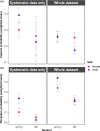Hare's affairs: Lessons learnt from a noninvasive genetic monitoring for tracking mountain hare individuals
- PMID: 33005371
- PMCID: PMC7520196
- DOI: 10.1002/ece3.6676
Hare's affairs: Lessons learnt from a noninvasive genetic monitoring for tracking mountain hare individuals
Abstract
Systematic monitoring of individuals and their abundance over time has become an important tool to provide information for conservation. For genetic monitoring studies, noninvasive sampling has emerged as a valuable approach, particularly so for elusive or rare animals. Here, we present the 5-year results of an ongoing noninvasive genetic monitoring of mountain hares (Lepus timidus) in a protected area in the Swiss Alps. We used nuclear microsatellites and a sex marker to identify individuals and assign species to noninvasively collected feces samples. Through including a marker for sex identification, we were able to assess sex ratio changes and sex-specific demographic parameters over time. Male abundance in the area showed high fluctuations and apparent survival for males was lower than for females. Generally, males and females showed only little temporary migration into and out of the study area. Additionally, using genotyped tissue samples from mountain hares, European hares (Lepus europaeus) and their hybrids, we were able to provide evidence for the first occurrence of a European hare in the study area at an elevation of 2,300 m a.s.l. in spring 2016. For future monitoring studies, we suggest to include complementary analysis methods to reliably infer species identities of the individuals analyzed and, thus, not only monitor mountain hare individual abundance, but also assess the potential threats given through competitive exclusion by and hybridization with the European hare.
Keywords: capture–mark–recapture; conservation; genotyping error rates; lagomorphs; nuclear microsatellites.
© 2020 The Authors. Ecology and Evolution published by John Wiley & Sons Ltd.
Conflict of interest statement
We have no conflict of interest to declare.
Figures







Similar articles
-
Overcoming species barriers: an outbreak of Lagovirus europaeus GI.2/RHDV2 in an isolated population of mountain hares (Lepus timidus).BMC Vet Res. 2018 Nov 26;14(1):367. doi: 10.1186/s12917-018-1694-7. BMC Vet Res. 2018. PMID: 30477499 Free PMC article.
-
Introgression of mountain hare (Lepus timidus) mitochondrial DNA into wild brown hares (Lepus europaeus) in Denmark.BMC Ecol. 2006 Nov 15;6:17. doi: 10.1186/1472-6785-6-17. BMC Ecol. 2006. PMID: 17105672 Free PMC article.
-
Mountain- and brown hare genetic polymorphisms to survey local adaptations and conservation status of the heath hare (Lepus timidus sylvaticus, Nilsson 1831).Sci Data. 2022 Nov 3;9(1):667. doi: 10.1038/s41597-022-01794-5. Sci Data. 2022. PMID: 36329035 Free PMC article.
-
Mountain hare transcriptome and diagnostic markers as resources to monitor hybridization with European hares.Sci Data. 2017 Dec 5;4:170178. doi: 10.1038/sdata.2017.178. Sci Data. 2017. PMID: 29206218 Free PMC article.
-
Unstable dynamics and population limitation in mountain hares.Biol Rev Camb Philos Soc. 2007 Nov;82(4):527-49. doi: 10.1111/j.1469-185X.2007.00022.x. Biol Rev Camb Philos Soc. 2007. PMID: 17944616 Review.
Cited by
-
Temperature increase and frost decrease driving upslope elevational range shifts in Alpine grouse and hares.Glob Chang Biol. 2021 Dec;27(24):6602-6614. doi: 10.1111/gcb.15909. Epub 2021 Oct 10. Glob Chang Biol. 2021. PMID: 34582611 Free PMC article.
-
Yearly Variations in GCM Concentrations in Female Mountain Hares (Lepus timidus) and the Effect of Pregnancy.Animals (Basel). 2021 Sep 16;11(9):2710. doi: 10.3390/ani11092710. Animals (Basel). 2021. PMID: 34573677 Free PMC article.
References
-
- Acevedo, P. , Jimenez‐Valverde, A. , Melo‐Ferreira, J. , Real, R. , & Alves, P. C. (2012). Parapatric species and the implications for climate change studies: A case study on hares in Europe. Global Change Biology, 18, 1509–1519. 10.1111/j.1365-2486.2012.02655.x - DOI
-
- Allendorf, F. W. , Leary, R. F. , Spruell, P. , & Wenburg, J. K. (2001). The problems with hybrids: Setting conservation guidelines. Trends in Ecology & Evolution, 16, 613–622. 10.1016/S0169-5347(01)02290-X - DOI
-
- Allendorf, F. W. , Luikart, G. , & Aitken, S. N. (2013). Conservation and the genetics of populations. Oxford, UK: Wiley.
-
- Bauer, K. (2001). Lepus europaeus In Spitzenberger F. (Ed.), Die Säugetierfauna Österreichs (pp. 317–324). Graz, Austria: Bundesministerium für Land‐ und Forstwirtschaft.
Associated data
LinkOut - more resources
Full Text Sources
Other Literature Sources
Miscellaneous

